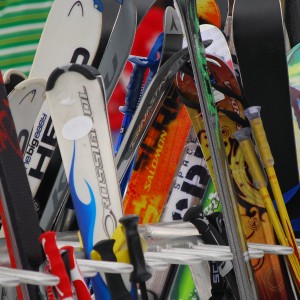 For the 2012/2013 winter season, ski design looks to be continuing the trend we’ve seen over the past few years – skis are tending to become longer, fatter and increasingly include design features that only a few years ago would have been considered the preserve of niche big mountain skis.
For the 2012/2013 winter season, ski design looks to be continuing the trend we’ve seen over the past few years – skis are tending to become longer, fatter and increasingly include design features that only a few years ago would have been considered the preserve of niche big mountain skis.
Once upon a time, the choice for skiers seemed to be between a race-focused on-piste ski which could hold its line in icy conditions, but which would sink and flounder on anything other than a perfectly groomed piste, and a long, wide ski that would be great for floating though a powder field but completely unusable on piste. Increasingly though, “all mountain” or freeride skis are proving that that they can handle both piste and off-piste conditions, allowing skiers to pick just one pair of skis for the majority of their skiing needs.
The new all mountain skis accomplish this go-anywhere feat through a number of design traits. Firstly, they are considerably wider than a classic on-piste ski – typically, around 90mm under the bindings. Secondly, they retain the hourglass shape of carving on-piste skis, getting wider still in the tip and the tail so that when put onto their edges, they can still carve a tight radius turn. For example, the Scott Crusade’s 133-92-122 shape means that despite its length and width under foot, its radius is only 15m – comparable to a more piste-focused ski. For 2012/2013, the Salomon BBR skis return for their second season with 7 models (up from the 2 last year). With their oversized tips drawing inspiration from water skis and surfboards, this time round there is a new BBR 10 which is 97mm underfoot (review coming soon!)
In addition, all mountain skis are getting longer – whereas once a “50/50” ski might have come up to a skier’s chin, now all mountain skis are tending to reach the forehead or above. This extra length is helpful in deep snow, where it helps provide flotation and to stop the tips from digging in, but can potentially make the skis less handy on piste. Here however, another new trend is continuing to have an impact – the “rocker” – also known as an “early rise” or reverse camber ski. While a traditional ski, placed flat on the ground, has a camber that means its tip and tail rest on the ground while the middle of the ski is in the air, rocker skis are flat, or even have a slight rise towards the tip.
Originally, this was viewed as a feature for hardcore powder skis to help them float and turn in deep snow. As with last season, it looks that in 2012/2013 an increasing number of all mountain skis are going to be using a rocker profile with the intention that it will help both on and off piste. On piste, the rocker has the effect of shortening the effective edge of the ski that is in contact with the snow, so that despite its overall length it handles like a shorter piste-focused ski. Off piste, the shape and length help stability and flotation – the best of all worlds!
The new all-mountain skis allow a skier the versatility to tackle all the conditions they might face on a typical day in the mountains – icy boilerplate runs to the resort, chopped up crud, smooth groomers and soft powder. While a skier who only ever skis either on piste, off piste or in the park might prefer a more specialised ski, for many skiers the modern all mountain ski is the key to go-anywhere fun!
As with last season, Snowgenius.com will be reporting and reviewing the key new skis throughout the 2012/2013 season.

